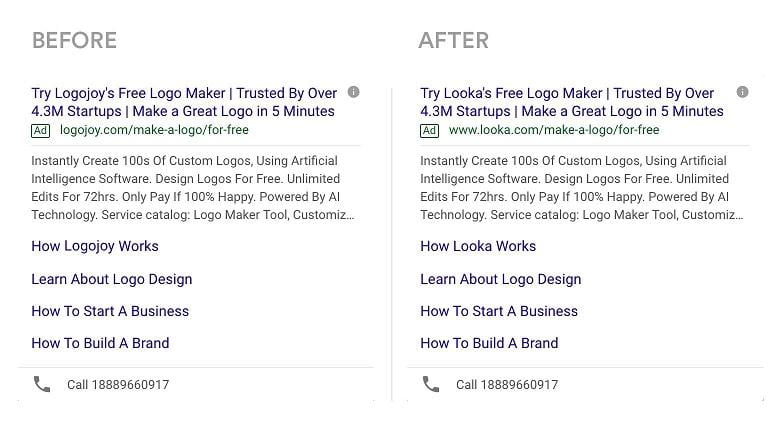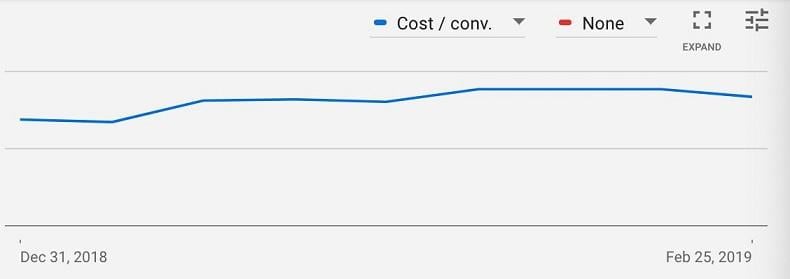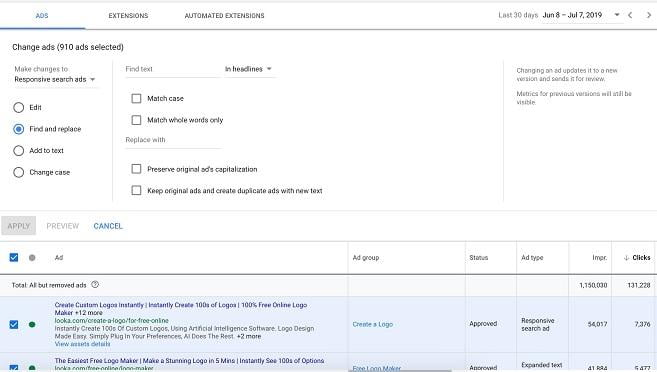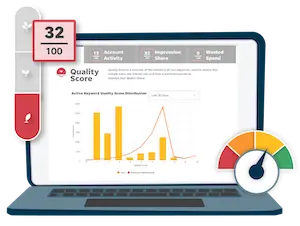
Rebranding a company is no easy feat, especially if it involves a name change and new website domain. Take it from us—earlier this year, we rebranded from Logojoy to Looka after months of planning and hard work.
Because Google Ads is such a huge acquisition channel for us, it was imperative to create a campaign strategy for the rebrand months in advance. We made some mistakes and learned a few valuable lessons along the way, and we wanted to share with other companies embarking on a similar process. It’s daunting, but you can do it.
With that, here’s our 11-step checklist to updating your Google advertising campaigns for rebrand success.
What to do before your rebrand launch
The first eight steps on this list should happen four to five months before your company rebrand launch day. This will give you plenty of time to test, troubleshoot, and pull in any other team members you may need to assist you.
1. Decide to update your existing search campaigns or create new ones
Unless your rebrand is targeting a completely new market with its own set of keywords, or you’re launching a new brand or product offering (e.g., a sub-brand under your main brand), you’re almost always better off updating your existing search campaigns.
This way, you’ll be able to leverage previous learnings and performance. If you do fall into the scenario where you’re targeting different keywords, prepare to create a whole new search campaign.
2. Ensure conversion tracking is in place on your new site
If you’re changing your domain name and planning to (eventually) shut down your old site and redirect all traffic to the new site, you can implement the same Google Ads conversion tag from your existing account. Doing this should make life much simpler for you (and your devs!).
3. Make sure your account is fully optimized.
Before the rebrand, make sure you have at least three expanded text ads and one responsive search ad in rotation per ad group. If you’re targeting the same keywords, you should already have this in place, or be in a position to get your account optimized and in excellent shape before the rebrand.
Make sure to:
- Take full advantage of all relevant ad extensions (e.g., sitelinks, callouts, price).
- Scrub search terms of irrelevant queries.
- Get your keyword Quality Scores to at least an 8 or 9.
4. Avoid any major changes to your search account
If you’re using automated bidding strategies, such as target CPA or target ROAS, you want to make sure that the algorithm is as stable as possible. This stability will allow you to isolate any drop in performance to the rebrand (whether it’s due to a new landing page, ad copy, or something else).
The bottom line? If you’re planning to make any major changes to your search account, implement them early and let the dust settle well before the rebrand launch date.
5. Make a list of all the places you’ll need to update your brand name
It’s easy to forget just how many spots your brand name appears. Take the time to review your copy with eagle eyes, checking for your name in the following places:
- Expanded text/responsive search ad copy (including headlines, descriptions, and display paths).
- Ad extensions.
- Landing pages (including the final URLs of your ads and ad extensions).
6. Test your new site’s landing page conversion rate
Assuming that both your new website and old website will be live at the same time (at least for a short period), use Google Ads’ campaign drafts and experiments to start sending a percentage of traffic to your new site. Within your campaign draft, update your ad copy, ad extensions, and landing pages to the new brand name.
Important: Before you launch into a quick “find and replace” to update your old brand name to your new one, make sure to consider a few things.
- Character length: If your new brand has fewer characters than your old brand, you’re in luck and replacing the copy will work out fine! If your new brand name is longer than before, you’ll need to adjust your ad copy accordingly to meet the set character count.
- Context: Will your messaging stay the same? Does your new brand have a different value proposition that you’d like to address in your ad copy? If so, take the time to craft new copy that aligns with your new website.
- Landing page relevance: Will your new landing page still be relevant to user search queries? In our case, the messaging of “make a logo” changed to “design a brand,” so we had to adjust our landing pages accordingly.
After launching your new experiment, monitor the conversion rate closely. The farther out from your launch date you start testing, the more time you’ll have to gather data for statistical significance and optimize your landing page accordingly. We learned this the hard way by testing our new landing pages too late and not achieving statistical significance before our launch date, but you can learn from our mistake. Continue to iterate on different landing pages until you’ve reached a conversion rate that’s as strong—if not stronger—than your old website.
7. Prepare your branded search campaigns
While you should already be running branded search campaigns, it’s even more essential for you to have branded search ads live during a rebrand, as you need to make people aware of the switch before your competitors jump on your old branded search terms.
Again, don’t make our mistake: At the time of our rebrand launch, we unfortunately didn’t have the capacity to build out our branded search campaigns. This led to other logo makers bidding on our branded terms at a time when we were advertising heavily for the rebrand, thus stealing our earned traffic. Eventually, we realized this lost opportunity and prioritized it, and we have been seeing great results ever since.
If you already have an existing branded search campaign currently running, then you’re already two steps ahead! Just make sure to:
- Draft new ad versions to communicate the rebrand for users searching for your old brand.
- Schedule your new ads to go live on your rebrand launch day (and schedule your old ads to pause on the same day). You can do this by applying different labels to your new ads and old ads and using automated rules to set them live.
You’ll also need to create a new branded search campaign for your new brand, ensuring that your ad copy addresses the rebrand with language like “formerly” or “is now,” and schedule this campaign to go live on your rebrand launch day.
8. Create additional sitelink extensions that drive to a dedicated landing page explaining the rebrand
Give people the opportunity to learn more about your rebrand if they have questions about why you’ve changed your name or if they have doubts that you’re the same company. The best way to do this is to create a dedicated landing page that includes sections like:
- Why are we rebranding?
- What’s changing?
- Frequently asked questions
Once the landing page is ready, add the sitelink extensions to your ads and schedule them to go live on launch day.
What to do the day of your rebrand launch
It’s happening! On the day of your rebrand launch, have a dedicated individual or team in place to complete the next three steps.
9. Update your existing campaign’s ad copy, ad extensions, and landing pages
If you have a winning experiment that’s currently running, this part is easy—simply go ahead and apply that experiment.
If you don’t have a winning experiment (or if you have a previous winner that already ended), then you’ll need to update everything manually. Assuming you’ve already checked for character length, context, and landing page relevance, you can simply use the “find and replace” function to update the ads (i.e., change all mentions of your old brand name to your new brand name and change all landing pages to your winning landing page)
Note: Try to update your campaigns at a time of day where fewer people are searching for your keywords, such as late at night or early in the morning (tip: bring coffee).
10. Check that your branded search campaigns and additional ad extensions have gone live
We didn’t have branded search campaigns ready to go at the time of launch, and this was a mistake—learn from it! If you have your branded search campaigns prepared and scheduled (see steps 7 and 8), all this step requires is a quick check first thing in the morning to ensure they’re running smoothly.
Be sure to keep an eye on the following:
- Campaign status is set to “Enabled.”
- Start date is set to the correct date (i.e., your rebrand launch date).
- Your new ads are enabled and approved (and your old ads are paused).
- Impression and click data are coming through (don’t worry if it’s not a lot yet, it is a new brand after all!).
11. Monitor results closely and make adjustments as necessary.
Take a deep breath and get ready for ad performance to take a slight dip—don’t freak out if the conversion rate is slightly lower than average right out of the gate. Rest assured that if you’ve done all the right prep work, performance should recover quickly (if not skyrocket past your old campaigns).
Here are a couple of tips to get you through the first few days after launch:
- If your customers take a few days to convert, monitor your “day one” conversion rate over a few weeks before the rebrand to have a benchmark for when the rebrand is live. Because users will be familiarizing themselves with your new website, they’ll likely need a few days before they convert, hence the lower conversion rate in the beginning.
- If a dip in conversion rate continues beyond the first few weeks, check to make sure there’s not a technical issue with tracking. If not, you’ll need to test new landing pages as soon as possible.
- If you’re using automated bidding, such as target ROAS or target CPA, consider loosening your targets for the first two or three weeks after the rebrand launch to allow the algorithm to bid more aggressively and offset any short-term decreases in conversion rates.
- Don’t be afraid to keep tweaking your ad copy and landing pages. After running several tests post-launch, our conversion rates are now stronger.
Ready to rebrand
And there you have it! With some careful updating, optimization, and testing of your search campaigns, you’ll be able to tackle your company rebranding with confidence.
But remember: Start early and pay attention to details! By doing everything you can to ensure your ads run smoothly—and in alignment with your new name, domain, and messaging—you’ll be giving your new brand the best chance at success and adoption by both current and future customers.
When all of that happens, you’ll be able to call your rebrand a resounding success (at least from a paid search standpoint)!
About the author
Matthew Sison has over four years of experience in digital marketing, with a specialty in pay-per-click and social media marketing. He’s currently leading paid acquisition at Looka, an AI-powered online logo maker that empowers entrepreneurs to easily design and launch their new business.














